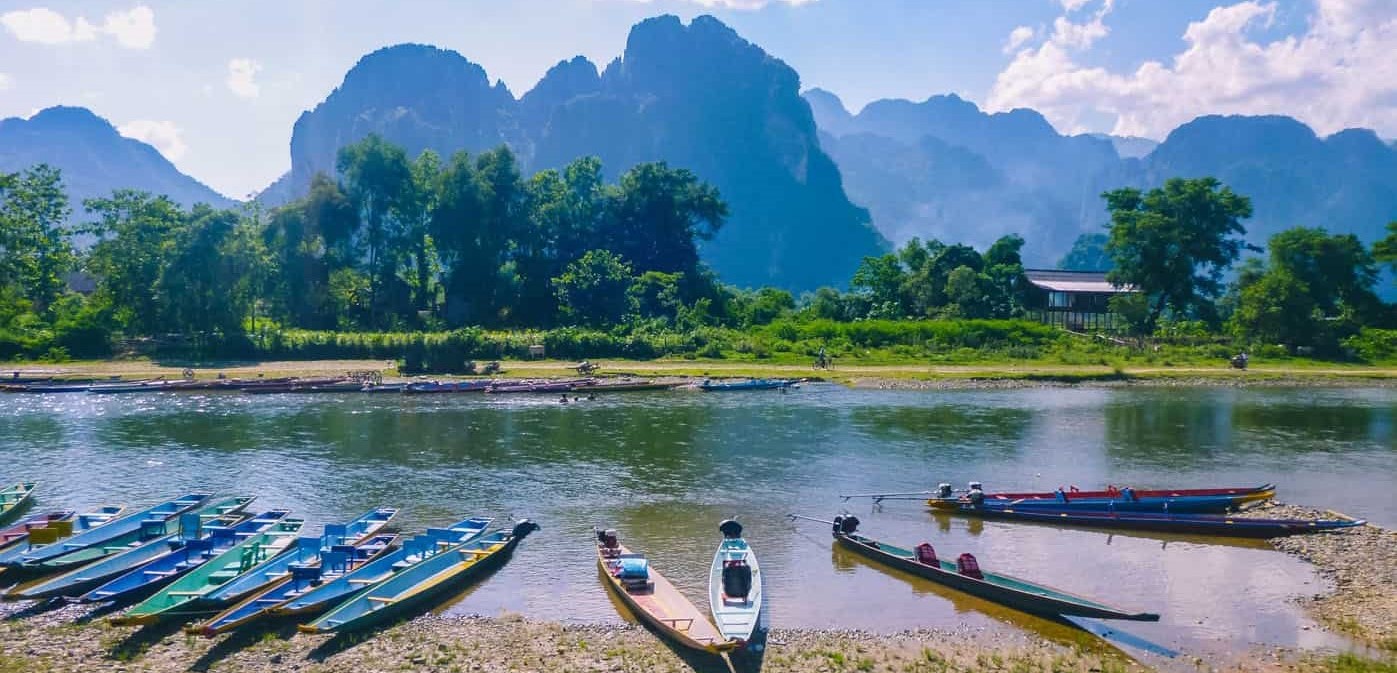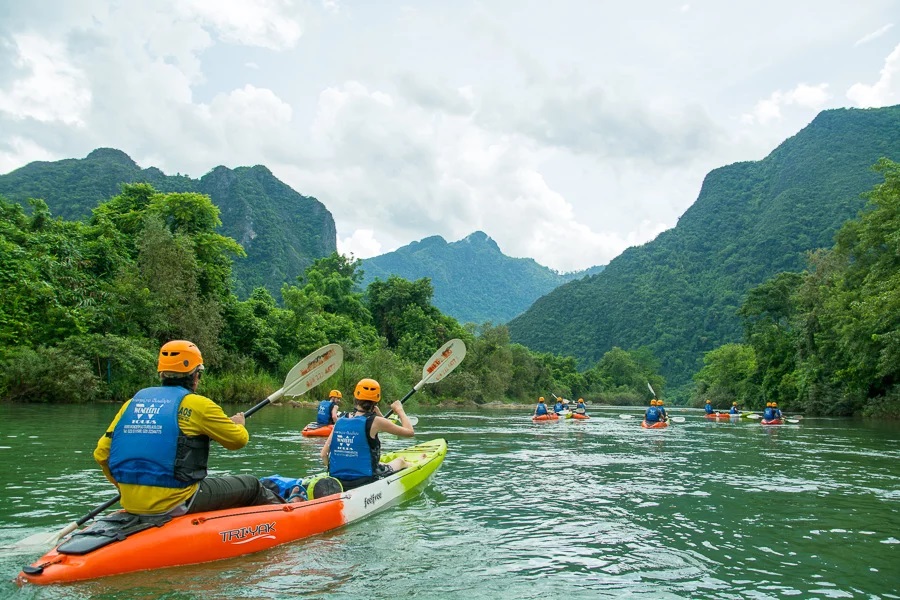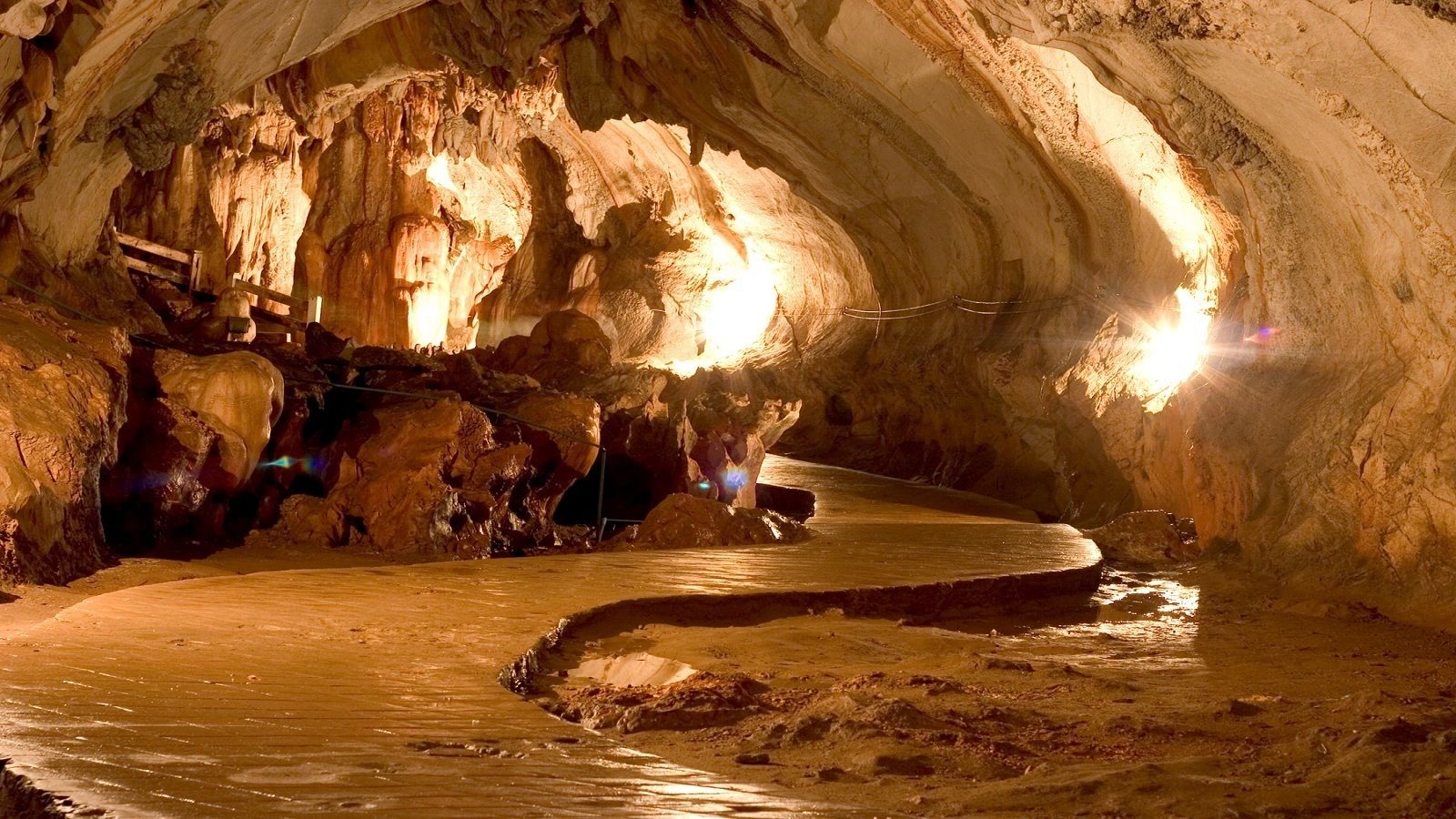Vang Vieng

Vang Vieng is a tourist-oriented town in Laos in Vientiane Province about four hours bus ride north of the capital. The town lies on the Nam Song River. The most notable feature of the area is the karst hill landscape surrounding the town. Population is 25,000.
Vang Vieng was first settled around 1353 as a staging post between Luang Prabang and Vientiane. Originally named Mouang Song after the body of the deceased King Phra Nha Phao of Phai Naam was seen floating down the river, the town was renamed Vang Vieng during French colonial rule in the 1890s.

In more recent times, the town has grown substantially due to the influx of backpacker tourism due to the opportunities for adventure tourism in a limestone karst landscape.

Places of interest in Vang Vieng
The town lies along the scenic curve in Nam Song River and been a popular destination among backpackers, it is also considered as the little Khaosan Road of Laos. Vang Vieng has a picturesque landscape with striking karst limestone mountains, caves and ancient temples that can be explored.
Within the town of Vang Vieng are numerous monasteries date back the 16th and 17th centuries such as Vat Kang, Vat Chua Pan, Vat Si Vieng Song (Vat That), Vat Phong Phen and the most visited one Vat Si Suman. Surrounding the town are Hmong villages that can be visited and experience first-hand cultural setting of Laotians. Most of the travelers spend their time biking and strolling along the river banks, exploring the local villages and local villages in the area.
Crossing the Nam Song River via the main bamboo footbridge leads visitor to several caves that can be accessed by foot, bicycle or motorbike. Rough small dirt road winds towards the jungle reaching the base of the limestone karsts.
Pha Tang Mount situated closely to Bane Pan Tang besides Nam Song River. It is a stunning limestone mountain in its unique shape created by nature.
The most interesting attraction in Vang Vieng is the Tham Phu Kham cave. The cave is about 6 km from Vang Vieng situated on the other side of a blue-green stream that can be crossed via sturdy footbridge. Once on the other side a stiff 200 m climb leads to the caves entrance. The cave has no clear marked pathways a torch is needed to navigate the semi-darkness climb down to the reclining Buddha that lies in the main cavern.
Tham Sang another cave to be explored in Vang Vieng is positioned just above the banks of the Nam Song River and about 7 km north of Vang Vieng on the west side of the river. Tham Sang, the Elephant Cave contains stalactite that resembles an elephant. Buddha images are also seen inside the cave.
Numerous guesthouse as well as restaurants filled the district. Guesthouses range from US$ 10 to US$ 30. There are also post office, banks, internet shops and a number of travel agencies sprouting around the Vang Vieng.
Vang Vieng does not offer much places to explore. The town’s enchantment works by just being there and feeling the laidback atmosphere spread throughout the town. Travelers must take note that Vang Vieng is a placed where opium can easily bought. There are establishments that offers “happy meals” in which opium are mixed with the food being served. Thefts also occur in area particularly at some caves. So it is advisable take necessary precautions
Tham Phu Kham cave

Tham Phu Kham Cave is considered sacred by Lao, famous for the lagoon and Buddha statue in the cave.
Vang Vieng is a popular ecotourism destination, this place is extremely suitable for adventures because of many limestone mountains and caves. The most attractive landscape in Vang Vieng is Tham Phu Kham cave, located to the northeast of Ba Na Thong village with Blue Lagoon.
Tham Phu Kham Cave has a dangerous warning sign in the entrance so tourists need a local tour guide leading you how to move in this cave. There is no stair to climb the hill, you must follow a hiking trail to reach Tham Phu Kham Cave.
The cave is covered by the dark so you need a torch by your side. It looks like a matrix including some sub – cave, filled with stalactites, the air is cold and wet. A hole on the top brings the sunshine into the first cave which have a huge bronze lying Buddha statue. While some sub-cave is quite easy to move, the others are difficult to enter. Tourists even have to climb, crawl and wade in the water on the way. The deeper area, the harder path to follow. You can also see some small streams and underground waterfalls there. At the end of the cave, tourists can see a bridge across Nam Song river. Standing on this bridge, you will have a view of all Tham Phu Kham Cave area.
Opening hours: 8:00 am to 18:00 pm every day
How to get to Tham Phu Kham cave
Tourists can go to Tham Phu Kham Cave by tuk tuk or songthaew from Vang Vieng. Hiring a bike which costs US $1 – $3 is also an extremely interesting experience.
Blue Lagoon

Blue Lagoon is a small island on Nam Ngum river, about 7 km to the west of Vang Vieng. It include 2 lagoons: the right lagoon is for someone who prefer a peaceful place to rest on the clear water and the left deeper one is for youngers who love playing thrilling games. Tourists can hire a tube which costs about US $1. If you do not want to swimming, you can play volleyball in the lakeside and try some thrilling games such as: swing the ropes, jumping into the water from branches, etc.
This lagoon was named Blue Lagoon because of the clear blue water that you can see the fishes swimming in the bottom. The fishes are get used to these noisy activities, they still swimming very calmly even when people jump into the water.
The Blue Lagoon offers a pleasant and relaxing atmosphere. After a long time playing games or swimming, you can rent a tent to have meals and sleeping or lying on the grass to sunbathe. In the afternoon (after 4:30pm), children and locals often play football in different yards, this is a daily activities in this area. They are very friendly and excited when tourists ask to join in the football match.
The entrance fee is quite cheap, about US $3 per person.
Opening hours: from 8:00am to 18:00pm.
Kayak On River

Kayaking the Nam Song river is the best way for you to see the untouched nature around Vang Vieng. On both sides of the river, you will be able to see the stunning limestone mountains and observe the lives of the locals throughout the trip. It was one of the most photogenic kayak route you can experience in Laos.
Kayaking in Vang Vieng is best experienced during dry season when the Nam Song river is calm, allowing you to take in the beautiful scenery surrounding you. For the more adventurous, kayaking in wet season involves some rapids and a bit of effort as you negotiate the faster, higher waters.
Kaeng Nyui Waterfall
Kaeng Nyui waterfall is a 20-minute drive northeast of Vang Vieng through beautiful local villages and rural scenery. The Kaeng Nyui waterfall is part of a series of three waterfalls, the first, Kenlon, is a small waterfall which tumbles into a swimming hole. The second is Kaeng Nyui Waterfall itself, which has an impressive 34-metre drop and the third waterfall, Kaeng Nyeang, is inaccessible.
Upon arrival, it’s an easy five minute walk to the first waterfall. The paths are well maintained and there are several small wooden bridges crossing parts of the stream. After having a quick swim, continue on for 400 metres to the main falls. Kaeng Nyui Waterfall is at its best after rainy season when the falls are full and flowing fast – during dry season they virtually disappear down to a small trickle.
Getting to Kaeng Nyui Waterfall is pretty straightforward by either bicycle (although a pretty hot, arduous ride), motorbike, tuk-tuk or songthaew (expect to pay around 150,000 kip for a return trip). The park at Kaeng Nyui Waterfall also has a couple of small food stalls offering local snacks and drinks.
Tham Chang Cave

Tham Chang Cave is the only major tourist attraction within easy walking distance of Vang Vieng town.
Tham Chang Cave was an important feature during the early 19th Century. During this time it was used as a bunker in defense against the Yunnanese Chinese invaders. It is obvious to see why they used it as a bunker. There is an excellent view of the landscapes as far as the eye can see so they could know if the intruders were coming. The caves themselves are also a very good size meaning hundreds of people could fit inside.
Tham Chang Cave has some stalactites and stalagmites and some interesting colours on the walls from the effect of the minerals in the water dripping through the cave.
Opening hours:Monday to Friday from 08:00 to 11:00 and 13:00 to 16:00, and from 08:00 to 16:00 on Saturdays and Sunday.
Entrance to the area around Tham Chang Cave costs 20,000 Lao Kip and then a further 30,000 Lao Kip to enter the cave itself.
Wat Kang

Wat Kang is a small Buddhist temple located at the north end of Vang Vieng town in Laos.
Wat Kang is one of two Buddhist temples in Vang Vieng town centre, the other Wat That is a larger temple located a short distance to the north.
The ordination hall at Wat Kang is small but nicely decorated with paintings inside and out. It’s a great example of what a typical Laos temple looks like outside of major towns and cities such as Luang Prabang and Vientiane and founded without royal patronage.
Wat Kang also has two large Buddha statues under cover: a seated Buddha and a reclining Buddha. In addition there are also four smaller Buddha statues and a small chedi in front of the ordination hall.
The other significant feature of Wat Kang is its drum tower. In Laos drum towers are typically installed in a temple to mark the centre of a town or village. Wat That does not have a drum tower, which suggests that Wat Kang is the older temple which used to be in the centre of Vang Vieng town which has expanded southward since the time Wat Klang was established.
Wat Kang is open to visitors during daylight hours and admission is free.
A few hundred meters down the road, you’ll come across the gates to Wat That, another serene and quiet temple in the center of Vang Vieng. Like Wat Kang, Wat That has no entry fee.
The temple is built around an old stone chedi, or stupa, which houses a Buddhist holy relic. Although the surrounding temple buildings are fairly new, the chedi is much older, a remnant of an ancient temple built on the site.
